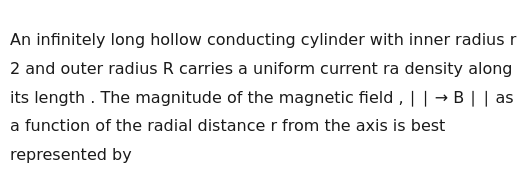Question
Question: An infinitely long hollow conducting cylinder with inner radius r 2 and outer radius R carries a...
An infinitely long hollow conducting cylinder with inner radius r 2 and outer radius R carries a uniform current ra density along its length . The magnitude of the magnetic field , ∣ ∣ → B ∣ ∣ as a function of the radial distance r from the axis is best represented by

Option 3
Solution
To determine the magnitude of the magnetic field ∣B∣ as a function of the radial distance r from the axis of an infinitely long hollow conducting cylinder, we use Ampere's Circuital Law. The cylinder has an inner radius r2 and an outer radius R, and carries a uniform current density J along its length.
Ampere's Circuital Law states: ∮B⋅dl=μ0Ienclosed Due to the cylindrical symmetry, the magnetic field B will be tangential to a circular Amperian loop coaxial with the cylinder, and its magnitude will be constant along the loop. Thus, ∮B⋅dl=B(2πr).
We analyze the magnetic field in three regions:
1. Region 1: r<r2 (Inside the hollow region) In this region, the Amperian loop of radius r encloses no current. Ienclosed=0 Applying Ampere's Law: B(2πr)=μ0(0) B=0for r<r2
2. Region 2: r2≤r≤R (Inside the conductor) In this region, the Amperian loop of radius r encloses the current flowing through the annular cross-section from r2 to r. The area of this annulus is Aenclosed=πr2−πr22=π(r2−r22). The enclosed current is: Ienclosed=J⋅Aenclosed=Jπ(r2−r22) Applying Ampere's Law: B(2πr)=μ0Jπ(r2−r22) B=2πrμ0Jπ(r2−r22) B=2μ0Jr(r2−r22)=2μ0J(r−rr22)for r2≤r≤R Let's check the behavior of B in this region:
- At r=r2: B=2μ0J(r2−r2r22)=2μ0J(r2−r2)=0. This matches the field in Region 1.
- To find the shape of the curve, we can look at the derivative: drdB=2μ0J(1+r2r22) Since drdB>0, the magnetic field increases as r increases.
- The second derivative: dr2d2B=2μ0J(−r32r22)=−r3μ0Jr22 Since dr2d2B<0, the curve is concave down.
- At r=R: Bmax=2μ0J(R−Rr22).
3. Region 3: r>R (Outside the cylinder) In this region, the Amperian loop of radius r encloses the total current flowing through the entire conductor. The total cross-sectional area of the conductor is Atotal=πR2−πr22=π(R2−r22). The total current is: Itotal=J⋅Atotal=Jπ(R2−r22) Applying Ampere's Law: B(2πr)=μ0Jπ(R2−r22) B=2πrμ0Jπ(R2−r22) B=2rμ0J(R2−r22)for r>R This shows that B is inversely proportional to r (B∝1/r) in this region.
- At r=R: B=2Rμ0J(R2−r22)=2μ0J(R−Rr22). This value matches the field at r=R from Region 2, ensuring continuity.
Summary of the behavior of B:
- For r<r2, B=0.
- For r2≤r≤R, B increases from 0 at r=r2 to a maximum value at r=R. The curve is concave down.
- For r>R, B decreases proportionally to 1/r.
Comparing this behavior with the given options (referring to the similar question's options as the question provides image options which are not rendered here but are present in the similar question), the graph that best represents this behavior is the one that shows:
- Zero magnetic field up to the inner radius r2.
- An increasing, concave-down curve for the magnetic field between r2 and R.
- A decreasing curve proportional to 1/r for the magnetic field beyond R.
This description matches option 3 from the similar question.
The final answer is Option 3
Explanation of the solution: The magnetic field is calculated using Ampere's Circuital Law for three regions:
- Inside the hollow region (r<r2): No current is enclosed, so B=0.
- Inside the conductor (r2≤r≤R): The enclosed current increases quadratically with r. The magnetic field B=2μ0J(r−rr22). This function increases from 0 at r=r2 to a maximum at r=R, with a concave-down shape.
- Outside the cylinder (r>R): The total current is enclosed. The magnetic field B=2rμ0J(R2−r22), which decreases inversely with r.
Answer: The graph corresponding to option 3 in the similar question best represents the magnitude of the magnetic field.
